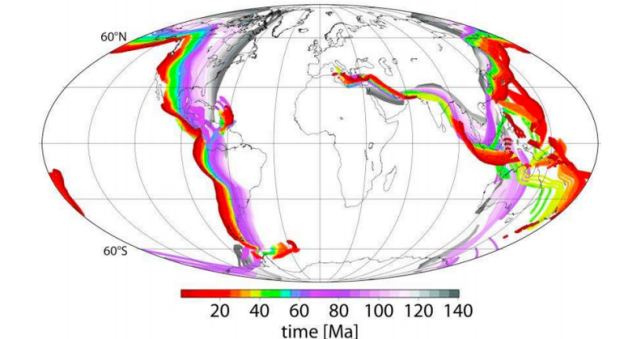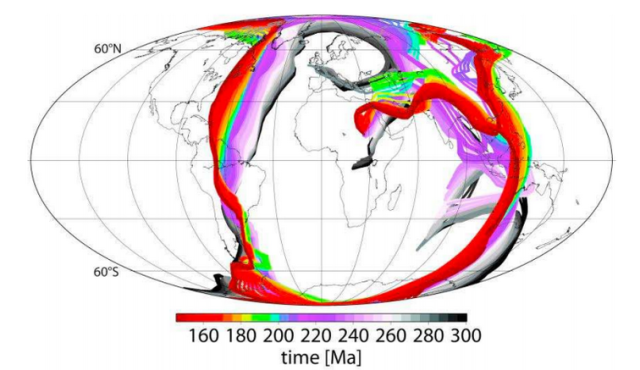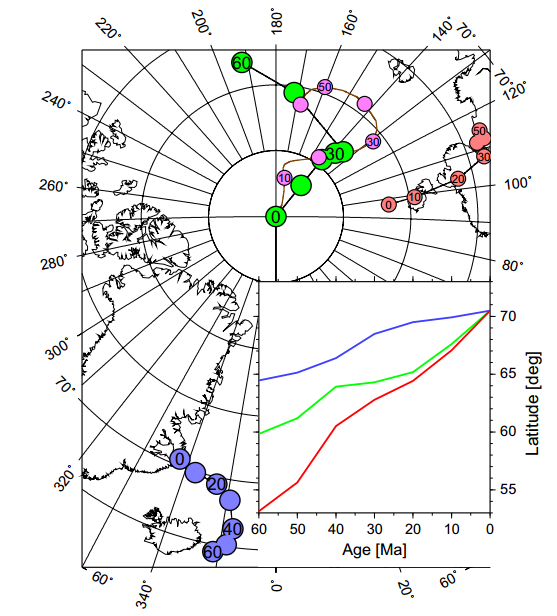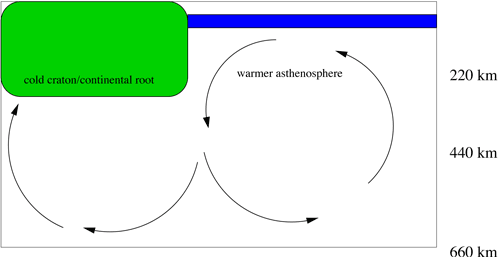Deep in the earth, solid rocks can flow, but the surface layers are cold rigid plates that move across the surface. This means that continents are constantly drifting across the earth and oceanic crust is being created and destroyed.
Plate tectonics is one of the most successful scientific theories of the Twentieth Century. It explains the major structures of earth’s surface and interior, the distribution of earthquakes and volcanoes, location of coal and mineral deposits, even where we find different types of fossil.
With modern global positioning satellite technology, we can directly measure the movements of the plates. They move about the speed your fingernails grow, a few centimetres a year. This isn’t fast on human time-scales, but on geological time-scales it means things are always changing. A geographical map of the earth from 100 million years ago looks very different and from 500 million years it’s unrecognisable. This is still only about 11% of the earth’s history.
Wegener’s theory of continental drift explained geological evidence from continents very well, but by the end of the 1950s it still wasn’t fully accepted for two main reasons. Firstly scientists knew the deep earth was solid but didn’t yet realise that hot solid rock can flow. Secondly our understanding of the rocks under the deep oceans was very limited.
Discovery of sea-floor spreading
During the second world war, new technologies were developed to measure the earth’s ocean depths as a way of detecting enemy submarines. After the war the US Navy funded surveys of the ocean depths to continue this work. Marie Tharp, a scientist working in the USA was involved in mapping out data from these surveys. In 1952 her mapping she identified a huge ridge down the middle of the Atlantic Ocean with a narrow valley at the very top. She interpreted this as a place where the earth was moving apart and linked it with the then controversial theory of continental drift.
Many didn’t believe her, but soon huge quantities of data were collected confirming her idea. The surveys of the ocean also measured the earth’s magnetic field, as the Navy hoped it would help with detecting steel submarines. These data showed a clear pattern of stripes parallel to the mid-ocean ridges identified by Marie Tharp.
Rocks cooling on the sea-floor contain magnetic minerals that capture a record of the earth’s magnetic field. This affects modern measurements of magnetism made above the rocks. The stripes are explained because the earth’s magnetic field changes back and forth over time (the Poles switch round). As crust is gradually created at mid-ocean ridges and drifts apart it slowly records the changing magnetic field.
DIAGRAM SHOWING SEA-FLOOR SPREADING https://en.wikipedia.org/wiki/Vine%E2%80%93Matthews%E2%80%93Morley_hypothesis
The idea of ‘sea-floor spreading’ and that these mid-ocean ridges were creating new crust was developed in the early 1960s. For the Atlantic it was shown in 1965 that if you remove these stripes one by one and bring the two sides back together, the continents fit closely together. In plate tectonic theory these types of boundary where plates are moving apart are known as divergent. Mid-ocean ridges are not straight lines, but are offset by breaks in the oceanic plates called transform faults. The ridges are not just found within the Atlantic, but also within the Indian and parts of the Pacific oceans.
Discovery of subduction zones
In the 1960s governments invested in a world-wide network of seismometers as a way of tracking underground nuclear tests. The data captured transformed our understanding of the earth as it greatly increases our understanding of earthquakes happen.
Earthquakes are formed where rocks break and move along large surfaces called faults. Earthquakes in the Atlantic are focused on the mid-Ocean ridges, caused by the stretching and movement of rocks in the rift zone. But the places where earthquakes are most common and strongest are found not in the Atlantic but around most of the Pacific and mark not where crust is made but where it is destroyed.
The earth isn’t growing bigger, so if oceanic crust is being made in the Atlantic, it must be being destroyed elsewhere. The Pacific oceanic plate is surrounded by subduction zones where lithosphere (oceanic crust plus attached mantle that together forms the plate) sinks down into the earth’s mantle. These are a type of convergent plate boundaries. At the surface subduction zones can be recognised by deep trenches formed where the oceanic lithosphere bends down. The Marianas Trench is the deepest, but they exist all around SE Asia and also down most of the west side of the Americas.
As the oceanic lithosphere sinks into the earth there are sudden slips and jolts as it pushes its way down which cause large earthquakes that are very dangerous. Once scientists had enough data, they could see in the patterns of earthquakes the location of the plate as it sinks into the earth. The earthquakes were shallow near the trench and deeper further away forming a surface of earthquakes known as a Wadati-Benioff zone.
<<< Diagram of earthquakes coloured by depth. E.g. http://www.isc.ac.uk/ home page >>
This surface marks roughly the top of the oceanic plate and earthquakes form as it forces its way deep down into the earth. As it sinks it also heats up and water within the plate is forced out into the mantle above, which melts causing volcanoes at the surface.
diagram of subduction zone, e.g. https://en.wikipedia.org/wiki/Subduction
Volcanoes exist all around the Pacific, the so-called ‘ring of fire’, from New Zealand, through the Philippines, Japan, Alaska, Canada, USA and down through central and South America. Armed with a global set of data on earthquakes, scientists were able to trace subduction zones across the world and in turn show that the ring of fire volcanoes all sit above them.
In the early 1950s, Marie Tharp was not believed as continental drift was so controversial. But by 1967 the ‘plate tectonics revolution’ was complete. In that year, models showing the earth’s surface as 12 rigid plates moving across the surface were published. These explained all of the features and evidence we’ve mentioned so far in a consistent and powerful way. Plate tectonics theory now underlies all of modern Earth Science.
https://en.wikipedia.org/wiki/Plate_tectonics#/media/File:Plates_tect2_en.svg
Plate tectonics around the world
Looking at a map of plates and a topographical map of the world together is very interesting. Let’s go on a tour of the world and show how plate tectonics explains many things.
The south-western edge of Indonesia is a lovely example of a subduction zone. It has a deep trench, a clear Wadati-Benioff zone and a line of volcanoes that form the islands of Indonesia. This subduction zone caused an earthquake that in turn created a tsunami in December 2004 that killed 227 thousand people in 14 countries. The Australian plate is being subducted under a corner of the Eurasian plate but oceanic crust is also being created in a ridge down the middle of the Indian Ocean.
Patterns of plate movement are complicated. The earth is a sphere and plates are rotating on it, meaning that relative plate movements are different in different places and don’t necessarily make sense on a flat map. In the USA the Pacific NorthWest has subduction and volcanoes where the tiny Juan da Fuca plate is being subducted. But nearby in Southern California the plates are moving past each other (a transform plate boundary) so there are earthquakes but no volcanoes. The city of San Francisco was destroyed in 1906 by an earthquake on this plate boundary.
In some subduction zones the sediment sitting on top of the oceanic crust is scraped off and piles up above the subduction zone in a structure called an accretionary wedge. In the Caribbean the West Indies consists of two types of islands. First there is a curved line of volcanic islands stretching from Anguilla down to Grenada caused by subduction of the Atlantic under the Caribbean plate. The island of Barbados is linked to these islands culturally but sits further east. It’s is not volcanic but is a place where the accretionary wedge forms an island.
In some subduction zones oceanic lithosphere is sinking down below a different piece of oceanic lithosphere, rather than continental. Here the volcanoes form chains of islands and sometimes build up thick piles of crust called volcanic arcs. A lovely example of an arc of volcanoes is found in the Aleutian Islands in the North Pacific.
Eventually oceanic islands and arcs enter a subduction zone where they are far too thick to be subducted. They are scraped off and added to the other plate in a process called accretion. Japan and Alaska are both places where volcanic arcs have been added to continental crust multiple times in the past. This process is one way continental crust may be created.
Continental tectonics
Continental crust is very different from oceanic crust. All land on earth sits on continental crust, with the exception of volcanic islands like Iceland or Hawaii. It is different in composition, being much richer in Silica. It has a lighter density and is never subducted. It is not involved in sea-floor spreading or subduction, but it is affected by plate tectonics and not just because continents drift across the surface.
Continental crust is affected by all three types of plate boundary. The East Africa Rift is where a divergent plate boundary is being started. Two parts of Africa are being pulled apart, with the continental lithosphere being thinned and volcanic activity occurred. Within about 10 million years this will become a true plate boundary and oceanic crust will start forming in the wider rift as the fragments of continent completely break apart.
Transform plate boundaries are found in California, but also down the middle of the South island of New Zealand. Convergent plate boundaries involving continents are of two types. The western edge of South America is an example of oceanic crust converging with continental, where subduction causes volcanoes but also a large mountain range called the Andes.
Plate boundaries where two continents converge cause large mountain ranges. There used to be an oceanic plate called Tethys sitting between what is now the Eurasian plate (to the north) and the African and Indian plates. After this oceanic crust was fully destroyed, continents collided forming mountain belts. The Himalayan mountains were formed by India colliding into the Eurasian plate and the Alpine mountain chain in Europe, plus mountains in Turkey, Iraq and Iran from Africa hitting Eurasia. The Tethys oceanic crust was a complicated shape and some of it remains within the Mediterranean sea.
Plate boundaries within continents are not sharp or simple. The effects of the impact of the Indian and Eurasia plates extends all the way through China into Siberia. Plate tectonics describes rigid oceanic plates with sharp boundaries very well. Sometimes the term continental tectonics is used to describe the different ways in which continents behave.
At the same time as evidence to prove plate tectonics was building up, some scientists were thinking about how this theory could explain the earth’s history. They started to interpret old rocks in terms of plate tectonics. Big differences in fossils from locations now close together can indicate that an ancient ocean once existed between them. Slices of oceanic crust, known as ophiolites can be found within continents and also indicate where a now vanished ocean basin once was. Patterns of metamorphic and igneous rocks can also be used to trace ancient subduction zones (blueschist and eclogite rocks), volcanic arcs or contintental collision zones.
A geologist called Tuzo Wilson proposed the idea of a regular cycle, where oceans open and close again and again. Close around the edge of the North Atlantic, in both Europe and America there are the traces of an ancient continental collision zone called the Caledonides that marks where a now vanished ocean called Iapetus was destroyed. Some time in the future the Atlantic ocean will close and another collision zone be formed close to the old one.
Plate tectonics explains the modern earth very well and explains most of the earth’s history too. Modern research into plate tectonics looks to explain where it may or may not apply, for example on other rocky planets and the very early earth.
Mars and Venus are similar to earth in many ways, but neither have plate tectonics. The explanation may be simple: Mars be too small and cold for the rocks to mantle to flow properly. Venus may be too hot – it’s atmosphere is really effective at insulating the planet. Other explanations talk about the importance of water as a way of lubricating the subducting oceanic plates.
Another debate is around when plate tectonics started on earth. The early Earth had an internal temperature that was much hotter. For oceanic crust to subduct, it must be rigid enough to be pushed into the mantle and so if crust and mantle are hotter (like Venus now or the Earth in the distant past) then plate tectonics may not be possible. Instead blobs of crust sink down and hot plumes rising up are much more important. Rocks older than about 2.5 billion years old are different in many ways from those created now and maybe earth then was more like Venus now. Scientists are still debating these topics.
First publication by Xiaoduo Media in Front Vision. Front Vision is a Chinese online science magazine for children. My original English text produced with permission.












